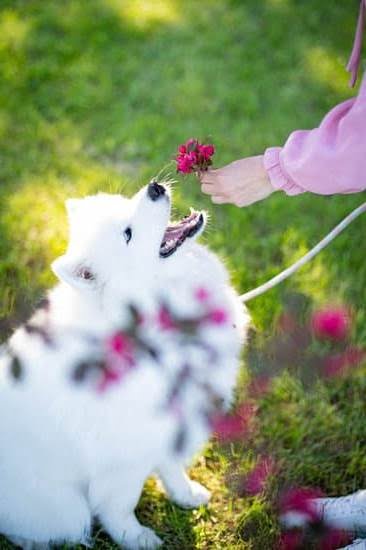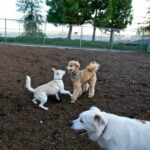Training a dog to respond to its name is an essential aspect of dog ownership. The ability for your furry friend to recognize and react promptly when called not only contributes to their safety but also enhances their overall well-being. In this article, we will explore the importance of teaching your dog name recall skills and how it can impact their behavior and interactions with both humans and other animals.
A dog that responds consistently when called can have a significant impact on their safety. Whether you’re in a park or at home, the ability for your dog to come when called helps prevent potential dangers such as running into the street or getting lost in unfamiliar surroundings. Additionally, training your dog’s name recall skills can make daily activities such as going for walks or trips to the veterinarian much easier and stress-free.
Beyond safety, teaching a dog to respond to its name also reinforces their bond with you as the owner. When a dog recognizes and responds positively to their name, it establishes trust between them and their human companions. This trust forms the foundation for effective communication and allows for more successful training sessions in the future. Moreover, a responsive dog creates opportunities for stronger relationships with family members and friends, making socialization easier and more enjoyable.
In the following sections, we will delve into various techniques and strategies for training your dog’s response to its name. From creating positive associations with their name through treats and rewards, incorporating verbal cues, phasing out treats gradually, practicing in different environments, addressing common challenges like distractions or fear/anxiety – all these aspects are vital in building reliable response from your furry friend.
By implementing ongoing training and reinforcement techniques outlined here, you’ll be on track toward enjoying the benefits of having a dog that responds promptly and safely whenever they hear their name being called.
Why Teaching a Dog to Respond to Its Name is Crucial for Its Safety and Well-being
Teaching a dog to respond to its name is not just a simple command, but a crucial aspect of their safety and well-being. Having a dog that responds promptly when called can help prevent accidents and potentially dangerous situations. This section will explore the reasons why training a dog to recognize and respond to its name is essential for their overall safety and well-being.
One of the main reasons why teaching a dog their name is crucial is that it allows for effective control in various situations. For example, if a dog starts to wander off during a walk or run towards something dangerous, being able to call their name and have them come back immediately can prevent them from getting into harm’s way.
Additionally, if a dog escapes from the home or yard, knowing their name can help retrieve them quickly before they encounter any dangers outside.
In addition to safety, teaching a dog to respond to its name also promotes better communication and bonding between the owner and the pet. When dogs recognize and respond promptly when called, it strengthens the trust and understanding between them and their owners. This enhanced communication allows for more effective training sessions, better behavior management, and an overall harmonious relationship.
| Key Benefits | Explanation |
|---|---|
| Enhanced Safety | A trained response to their name can prevent accidents or dangerous situations. |
| Better Communication | Responding to their name strengthens the bond between owners and dogs. |
| Incorporating Positive Reinforcement | Promotes learning through rewards rather than punishment. |
By highlighting the importance of teaching a dog to respond to its name for safety and well-being, owners can understand the significance of investing time and effort into this training. This awareness encourages responsible pet ownership, ultimately benefitting both the dog and their owners in the long run.
Understanding Basic Dog Training Techniques
Training a dog to respond to its name is a crucial part of their overall obedience and safety. However, it’s important to understand the different training techniques available and choose the one that aligns with your values and goals as a dog owner. In this section, we will explore two primary methods of dog training: positive reinforcement and punishment-based methods.
Positive reinforcement is a widely recognized and effective training technique that focuses on rewarding desired behavior rather than punishing undesired behavior. This method involves providing treats, praise, or other rewards when the dog responds correctly to commands or cues. By associating the correct response with something positive, such as a treat, dogs are motivated to repeat the behavior in order to receive the reward again.
On the other hand, punishment-based methods involve using aversive or unpleasant consequences as a means of discouraging undesired behavior. These consequences may include verbal reprimands, physical corrections such as leash jerks or collar grabs, or even more severe measures like shock collars. While punishment can temporarily suppress unwanted behaviors, it does not effectively teach dogs what they should do instead.
It is important to note that while punishment-based methods may yield short-term results, they can have detrimental effects on a dog’s emotional well-being and trust in their owner. Using positive reinforcement techniques builds a strong bond between you and your dog based on trust and mutual understanding. It promotes better communication and encourages your dog to make positive choices willingly.
When deciding which training method to use when teaching your dog to respond to its name, consider the long-term impact on their overall well-being. Positive reinforcement methods have been proven effective in promoting happier dogs who are eager to learn and please their owners. By choosing this approach, you are nurturing a relationship built on trust and encouraging your furry friend’s success.
- Positive reinforcement focuses on rewarding desired behavior rather than punishing undesired behavior.
- It involves providing treats, praise, or other rewards when the dog responds correctly to commands or cues.
- Punishment-based methods involve using aversive consequences to discourage unwanted behavior.
Knowing these differences will help you make an informed decision about the type of training that best suits your dog’s needs and your own training philosophy. In the next section, we will discuss how building a strong bond with your dog is foundational in their training journey.
Setting the Training Foundation
Building a strong bond with your dog is essential when training them to respond to their name. This foundation is crucial because it establishes trust, communication, and mutual respect between you and your furry friend. By taking the time to build a strong bond, you create a positive training environment where your dog feels motivated, confident, and eager to learn.
Spending Quality Time Together
One of the first steps in building a strong bond with your dog is to spend quality time together. Engage in activities that both you and your dog enjoy, such as playing fetch at the park or going on long walks. Regular exercise and mental stimulation are not only beneficial for your dog’s well-being but also create opportunities for bonding. These shared experiences help strengthen the connection between you and your dog.
Establishing Trust through Positive Reinforcement
Positive reinforcement is an effective training technique that can be used to establish trust and reinforce the bond with your dog. Whenever your dog exhibits good behavior or responds correctly to their name, reward them with treats, praise, or playtime. This positive association encourages them to repeat those actions in the future. Avoid using punitive methods or physical punishment during training sessions as this can damage the trust between you and your dog.
Consistency and Patience
Consistency is key when building a strong foundation with your dog. Establish clear rules and boundaries from the beginning of your training journey and ensure that everyone in the household follows them consistently. Dogs thrive on routine, so having consistent expectations will help them understand what is expected of them.
Additionally, patience plays a vital role in building a strong bond with your canine companion. Understand that dogs may not grasp concepts immediately or may make mistakes along the way. Stay calm, be patient, and provide support through gentle guidance rather than becoming frustrated or resorting to punishment-based methods.
By setting the training foundation with a strong bond, you create an environment where your dog feels safe, loved, and motivated to learn. This solid foundation will pave the way for successful training sessions as you move forward in teaching your dog to respond to their name.
Step-by-Step Guide
Choosing the Right Name for Your Dog: Factors to Consider
Before you can begin training your dog to respond to its name, it is important to choose the right name for your furry friend. There are several factors you should consider when selecting a name for your dog. First and foremost, choose a name that is easy to pronounce and has a distinct sound. Dogs tend to respond better to names that have one or two syllables, as they are easier for them to recognize and remember.
Another factor to consider is avoiding names that sound similar to common household commands or other family members’ names. This helps prevent confusion for your dog and ensures that it can easily distinguish between its name and other cues or individuals in the household.
Lastly, consider choosing a name that reflects your dog’s personality or physical characteristics. This not only adds a personal touch but can also make it easier for both you and your dog to bond with the name.
Creating Positive Associations: Making Your Dog Fall in Love with Its Name
Once you have chosen the perfect name for your dog, it is crucial to create positive associations with that name. This will help your dog form a strong connection between its name and positive experiences, making it more likely to respond promptly when called.
One way to create positive associations is by using treats and rewards during training sessions. Whenever you say your dog’s name and it looks at you or comes towards you, reward it with a treat or praise. This encourages your dog to associate its name with something pleasant and rewarding.
Additionally, incorporating playtime and fun activities into training can further reinforce the positive association with its name. For example, during play sessions, use its name followed by commands such as “come” or “fetch.” By associating its name with enjoyable activities, your dog will be more motivated to respond quickly when called.
Using Treats and Rewards: Motivating Your Dog to Respond Promptly
Positive reinforcement is a highly effective training technique when it comes to teaching your dog to respond to its name. Using treats and rewards as motivation can significantly increase the likelihood of a prompt response.
During the initial stages of training, have a stash of small, tasty treats on hand. When your dog responds to its name by looking at you or coming towards you, immediately reward it with a treat and praise. This reinforces the connection between hearing its name and receiving a reward, motivating your dog to repeat the behavior in the future.
As your dog becomes more consistent in responding to its name, you can gradually reduce the frequency of treat rewards. Transitioning from continuous rewards to intermittent or random rewards helps maintain your dog’s motivation while teaching it that even if it doesn’t receive a treat every time, responding to its name is still valuable.
Remember to choose high-value treats that your dog finds extremely rewarding and use them selectively during training sessions. This will help keep your dog engaged and excited about learning its name.
Additional Tips and Techniques
Fine-tuning your dog’s name recall skills is an essential part of training to ensure that your dog responds promptly and reliably to its name. These additional tips and techniques will help you enhance your dog’s recall abilities, making it easier for them to respond regardless of distractions or distance.
One important technique is gradually phasing out treats and transitioning to an intermittent reward system. While treats are effective motivators during the initial stages of training, it is crucial to wean your dog off constant treat rewards and introduce intermittent rewards instead. This helps prevent your dog from becoming dependent on treats and encourages them to respond even when there isn’t a treat involved.
To further strengthen your dog’s response in different environments, it’s essential to practice in various locations, both indoors and outdoors. Start in a familiar environment with minimal distractions, then gradually increase the difficulty level by introducing more distractions such as other people or animals. By consistently practicing in different settings, you’ll teach your dog to respond reliably regardless of their surroundings.
Adding distance and duration to the training is another important step in fine-tuning your dog’s name recall skills. Begin by calling your dog from a short distance, gradually increasing the distance as they become more comfortable with responding.
Similarly, gradually increase the duration for which they need to hold their attention on you after hearing their name before receiving a reward. This helps build reliability and ensures that your dog can respond no matter where they are or how long it takes.
Another valuable technique for maintaining a strong name recall is incorporating everyday interactions into training. Throughout daily activities such as playing or feeding, make a habit of calling your dog by their name before engaging with them. This reinforces the association between their name and action while also providing opportunities for ongoing practice outside dedicated training sessions.
By implementing these additional tips and techniques into your training routine, you can fine-tune your dog’s name recall skills and build a reliable response. Remember that consistency, patience, and positive reinforcement are key to successful training. With dedication and practice, you’ll enjoy the satisfaction of having a dog that responds promptly and safely to its name in any situation.
Troubleshooting Common Challenges
Training a dog to respond to its name can sometimes come with challenges and setbacks. It’s important to address these issues in order to ensure successful training and a prompt response from your dog. In this section, we will discuss some common challenges that dog owners may encounter during the training process and provide tips on how to overcome them.
One common challenge is dealing with distractions. Dogs can easily get distracted by their surroundings, other animals, or noises, which can make it difficult for them to focus on responding to their name. To manage your dog’s focus during training, start in a quiet and familiar environment with minimal distractions.
As your dog becomes more proficient at responding to its name, gradually increase the level of distractions. This will help your dog learn to respond regardless of the environment it is in.
Another challenge you may face is addressing fear or anxiety in your dog. Some dogs may associate negative experiences with their name or have general anxieties that affect their ability to respond. In these cases, it’s important to build confidence and trust through positive reinforcement techniques.
Use treats and rewards consistently during training sessions and create a safe and supportive environment for your dog. Gradually expose your dog to new experiences while using its name positively so that it learns to associate its name with positive outcomes.
Inconsistent responses from your dog can also be a frustrating challenge. Your dog may sometimes respond promptly, but other times ignore its name completely. To reinforce training for reliability, be consistent in both your cues and rewards during training sessions.
Practice regularly in different environments and situations so that your dog becomes accustomed to responding no matter the circumstances. If you notice inconsistent responses, go back a step in the training process and reestablish the association between the name and action by using treats or rewards as motivation.
By addressing these common challenges head-on and implementing appropriate techniques, you can overcome resistance and setbacks in training your dog to respond to its name. Remember that patience, consistency, and positive reinforcement are key when troubleshooting these challenges. With time and effort, you can enjoy the reward of having a dog that responds promptly and safely to its name.
Maintaining a Strong Name Recall
Now that you have successfully trained your dog to respond to its name, it is important to continue practicing and reinforcing this skill to maintain a strong name recall. Ongoing training and reinforcement will help ensure that your dog responds promptly and reliably in various situations and environments. In this section, we will explore some strategies for maintaining a strong name recall.
Incorporating Regular Name Calls during Playtime and Walks
One way to reinforce your dog’s response to its name is by incorporating regular name calls during playtime and walks. During these activities, randomly call out your dog’s name and reward them with treats or praise when they respond promptly. This will not only keep the name recognition fresh in their mind but also make the association between their name and positive experiences stronger.
To make it more challenging, gradually increase the distance between you and your dog when calling their name. This will help them learn to respond even when they are farther away from you. Additionally, practice calling their name in different environments with varying levels of distractions. By doing so, you can ensure that your dog’s response remains consistent regardless of the situation.
Engaging in Fun Games and Activities: Strengthening the Bond and Reinforcing Response
Engaging in fun games and activities with your dog is another effective way to strengthen the bond between you and reinforce their response to their name. Incorporate games such as hide-and-seek or recall challenges where you call your dog’s name from different locations, rewarding them whenever they find you or respond promptly.
You can also utilize interactive toys or puzzles that require your dog’s attention and problem-solving skills. Use their name as a cue while playing with these toys, rewarding them each time they engage with the toy after hearing their name.
Seeking Professional Assistance: When to Consider Dog Training Classes or Consult a Trainer
In certain cases where you encounter difficulties or want to take your dog’s training to the next level, it may be beneficial to seek professional assistance. Dog training classes or consultations with a trainer can provide valuable guidance and insights tailored to your specific needs and challenges.
A professional trainer can further assess your dog’s progress, offer personalized training techniques, and help troubleshoot any issues you may be facing. They can also provide additional exercises and strategies for maintaining a strong name recall as well as address any other training goals you have for your dog.
Maintaining a strong name recall is an ongoing process that requires consistency, patience, and dedication. By incorporating regular name calls during playtime and walks, engaging in fun games and activities, and seeking professional assistance when necessary, you will continue to reinforce your dog’s response to its name, ensuring safety and prompt communication in various situations.
Conclusion
In conclusion, training your dog to respond to its name is an essential skill that contributes to their safety and well-being. By establishing a strong foundation of positive reinforcement, choosing the right name, and creating positive associations, you can effectively teach your dog to recognize and respond promptly when called. Incorporating verbal and physical cues along with treats and rewards further strengthens the association between their name and desired action.
As you progress in training, it is important to fine-tune your dog’s name recall skills. Gradually phasing out treats and practicing in different environments will help them respond regardless of distractions. Adding distance and duration to the training sessions builds reliability from anywhere, while reinforcing training through everyday interactions ensures consistency in their response.
Addressing common challenges such as distractions, fear or anxiety, inconsistent responses, or age/health-related limitations are crucial in maintaining a strong name recall. By managing focus during training, building confidence and trust, reinforcing training for reliability, or adapting methods for puppies or older dogs, you can overcome resistance or setbacks.
To maintain a strong name recall throughout your dog’s life, ongoing training and reinforcement are essential. Incorporating regular name calls during playtime and walks reinforces their response. Engaging in fun games and activities strengthens the bond between you and your furry friend while reinforcing their prompt response.
In some cases, seeking professional assistance through dog training classes or consulting a trainer can provide additional guidance tailored to your specific needs. Remember that every dog is unique, so patience, consistency, and encouragement are key factors in achieving success.
By following these techniques and tips outlined in this article consistently over time, you will be able to enjoy the fruit of your efforts-a loyal companion who responds promptly and safely to its name. The rewards of having a well-trained dog extend beyond convenience; they contribute to a happier relationship between you both by fostering trust, communication, and companionship. So start training today to enhance the quality of life for both you and your furry companion.
Frequently Asked Questions
How long does it take a dog to learn its name?
The time it takes for a dog to learn its name can vary based on several factors. Generally, it can take anywhere from a few days to a couple of weeks for a dog to learn and recognize its name. However, some dogs may pick up their name quickly and respond almost immediately, while others may require more time and consistent training.
Patience, positive reinforcement, and regular practice are key in helping a dog learn its name. It’s important to use the same name consistently and avoid using confusing nicknames or variations that might hinder the learning process.
What if my dog doesn’t respond to her name?
If your dog doesn’t respond to her name, there could be a few reasons behind this behavior. Firstly, it’s crucial to consider if you have given your dog enough time to learn her name. Training takes patience and consistency, so giving it more time might help.
Additionally, evaluate if you are using the right techniques when teaching your dog her name. Positive reinforcement such as treats or praise can be effective motivators during training sessions. Using the same tone of voice consistently can also aid in capturing your dog’s attention when calling her by name.
How long does it take for a rescue dog to learn its name?
The time it takes for a rescue dog to learn its name can vary depending on several factors specific to the individual dog’s background and experiences prior to being rescued. Some rescue dogs may have had previous owners who taught them their names, making the process of recognizing their new name quicker and easier. However, others may come from challenging circumstances without any prior training or exposure to being called by a specific name.
In these cases, it might take longer for a rescue dog to learn its new name as they adjust to their new environment and build trust with their new caretakers. Consistency in training methods along with patience and understanding will greatly assist in helping rescue dogs learn their names over time.

Welcome to the blog! I am a professional dog trainer and have been working with dogs for many years. In this blog, I will be discussing various topics related to dog training, including tips, tricks, and advice. I hope you find this information helpful and informative. Thanks for reading!





